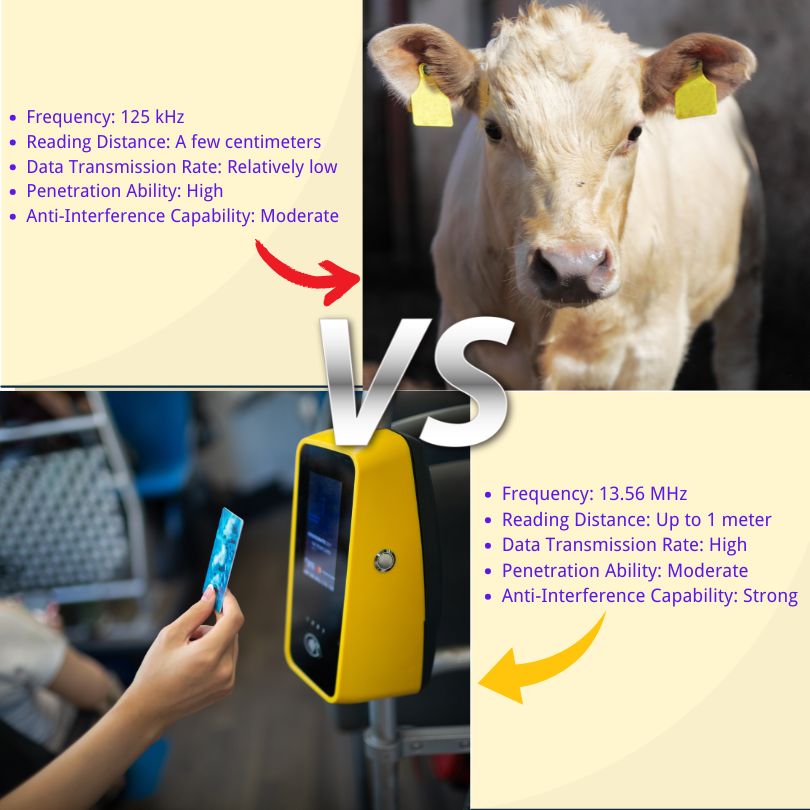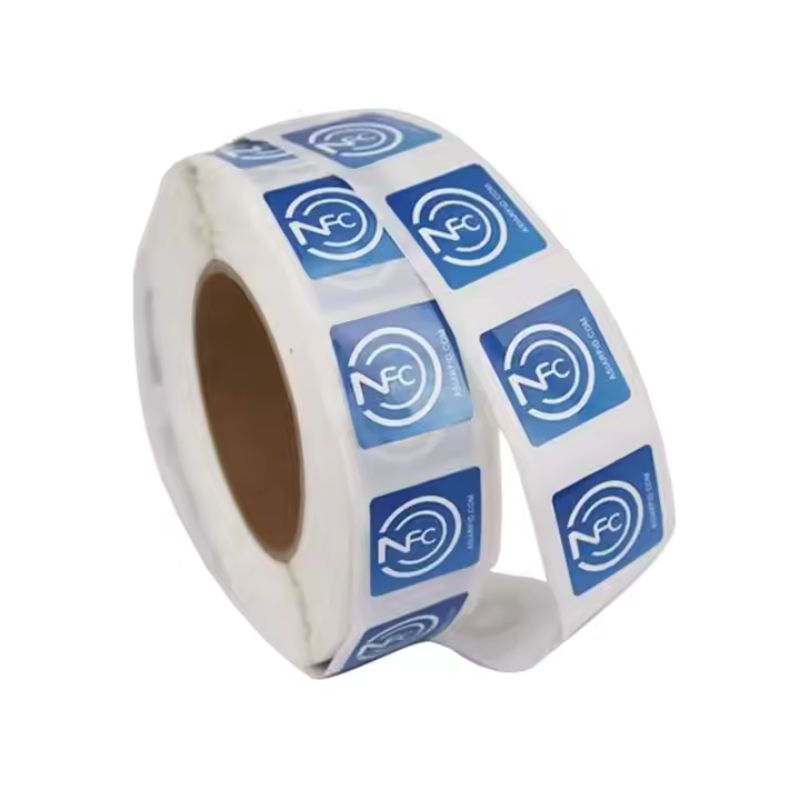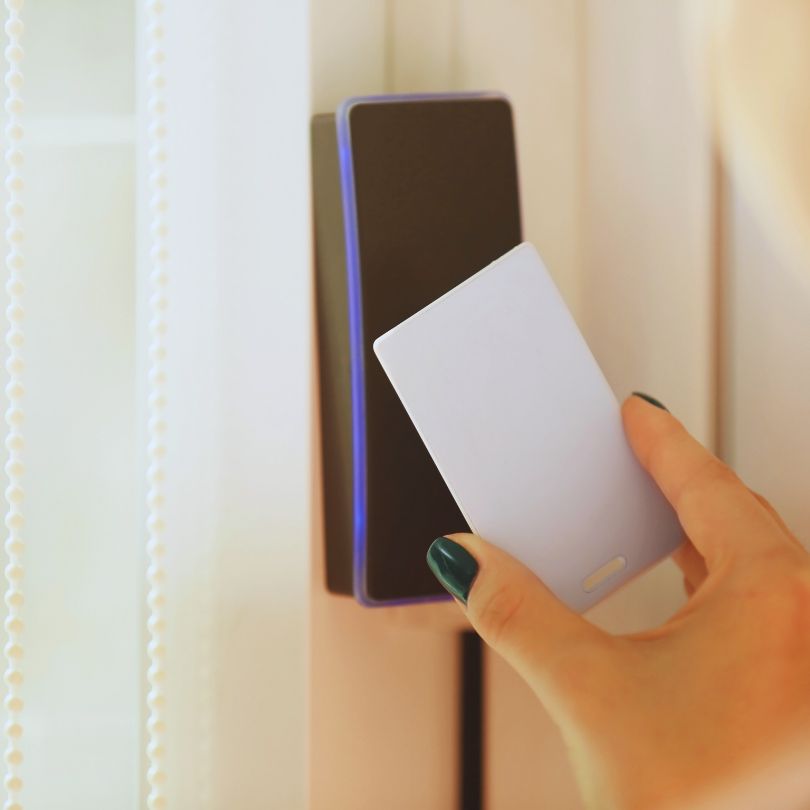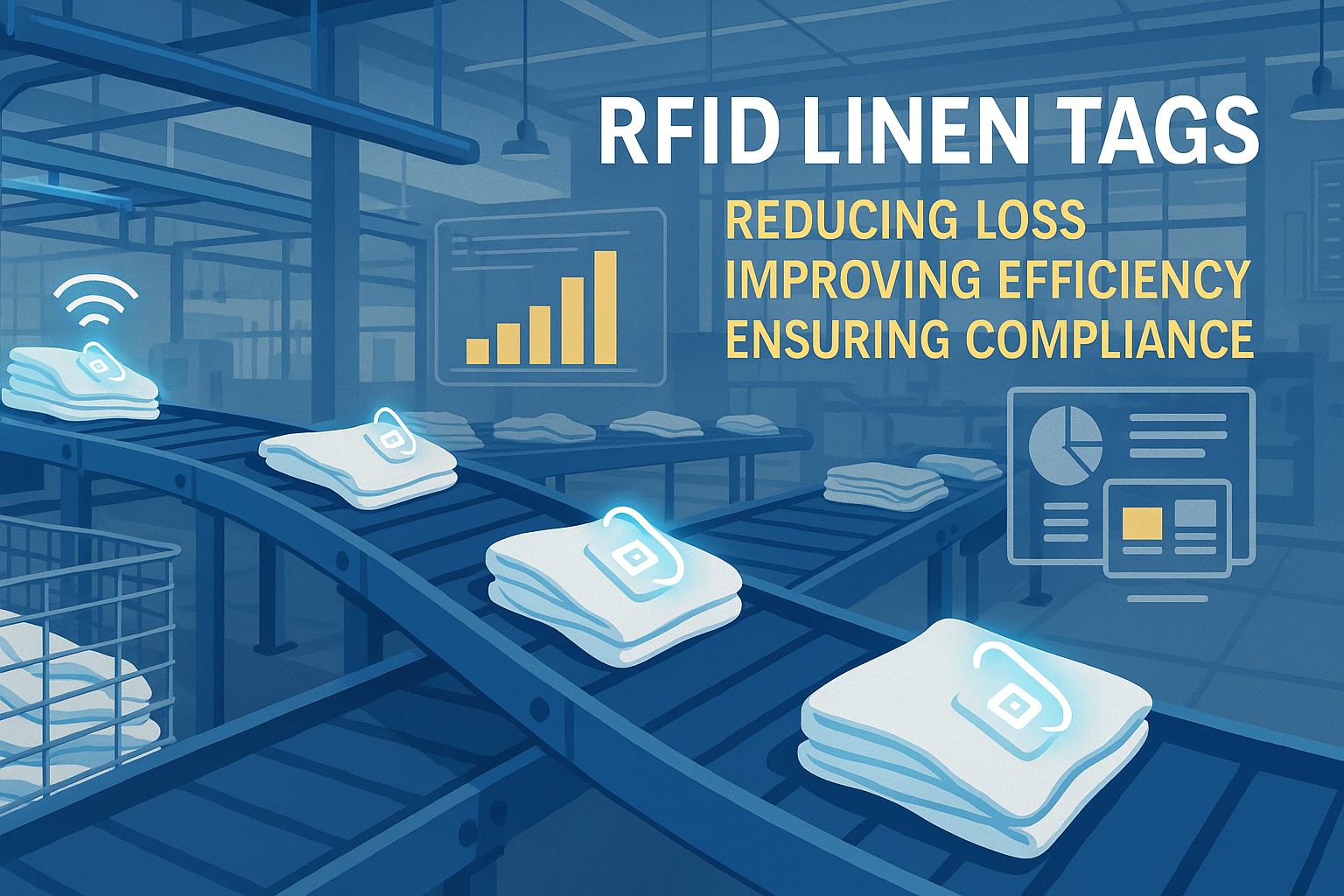
Forstå forskellene mellem 13,56 MHz og 125 kHz RFID-tags
Indholdsfortegnelse
Forstå forskellene mellem 13,56 MHz og 125 kHz RFID-tags

Hvad RFID-frekvens virkelig betyder (LF vs. HF)
RFID-systemer bruger radiobølger til at kommunikere mellem Tags og læsere. Den frekvens, de bruger, påvirker, hvor langt de kan læse, hvor hurtigt de sender data, hvordan de opfører sig i nærheden af metal eller vand, og hvilken type data de kan gemme.
Her er kerneidéen:
Lavfrekvens (LF) = 125 kHz RFID-tags
- Kort rækkevidde
- Langsommere datahastighed
- Fremragende ydeevne i nærheden af metal eller væsker
- Enkel, robust og prisvenlig
Højfrekvens (HF) = 13,56 MHz RFID-tags - Længere rækkevidde
- Hurtigere datahastighed
- Mere avanceret sikkerhed
- Kompatibel med NFC og smartphones
13,56 MHz mod 125 kHz
| Feature | 13,56 MHz RFID-tags | 125 kHz RFID-tags |
|---|---|---|
| Frekvens | 13,56 MHz (HF) | 125 kHz (LF) |
| Læs Range | Op til 1 meter | 2-10 cm |
| Dataoverførselshastighed | Høj | Lav |
| Ydeevne nær metal | Moderat | Stærk |
| Sikkerhed | Understøtter kryptering, gensidig autentificering | Grundlæggende, normalt ingen kryptering |
| NFC / Smartphone-understøttelse | Ja | Ingen |
| Koste | Højere | Sænke |

Sikkerhed: Er én frekvens mere sikker?
125 kHz RFID-tags bruges ofte i ældre systemer og bruger typisk faste unikke ID'er uden kryptering. Det gør dem nemme at klone med standardudstyr. De er fine til systemer med lav risiko, men de opfylder ikke moderne sikkerhedsstandarder.
13,56 MHz RFID-tags, især MIFARE- eller DESFire-kort, understøtter:
- Kryptering
- Gensidig autentificering
- Sikker hukommelseslagring
- Flere applikationer på et enkelt kort
Konklusion: - Hold dig til 125 kHz RFID-tags til lav sikkerhed (f.eks. skabsnøgler, tidsure).
- Vælg 13,56 MHz til adgangskontrol, betalinger eller ethvert system, der lagrer personlige data.
NFC og smartphone-kompatibilitet
Hvis dit projekt involverer telefoner, vil 125 kHz RFID-tags ikke fungere.
Kun 13,56 MHz RFID-tags understøtter NFC (Near Field Communication) – den teknologi, der bruges til mobile betalinger, check-ins og tap-to-pair-funktioner.
De fleste smartphones kan læse og skrive NFC-tags ved hjælp af 13,56 MHz, hvilket gør denne frekvens ideel til:
- Digitale billetter
- Event-check-ins
- Smarte plakater
- Loyalitetskort
- Kontaktløs mobil ID
Hvis smartphone-understøttelse er vigtig, er 13,56 MHz dit eneste valg.
Virkelige anvendelsestilfælde efter branche
| Branche / Anvendelse | 125 kHz RFID-tags | 13,56 MHz RFID-tags |
|---|---|---|
| Adgangskontrol | Grundlæggende adgangssystemer, ældre døre | Sikre legitimationsoplysninger, moderne ID-badges |
| Offentlig transport / Billetter | Ikke understøttet | MIFARE/NFC-baserede rejsekort |
| Dyresporing | Udbredt anvendelse på grund af vævsgennemtrængning | Sjælden |
| Industriel automatisering | Pålidelig i nærheden af metal/væske, robust brug | Mindre almindelig i barske miljøer |
| Sundhedspleje | Ikke ideel til patient- eller medicineringsovervågning | Bedre til sikker ID- og aktivmærkning |
| Biblioteker / Arkiver | Sjælden | Populært til bogsporing og udlån |
| Marketing / Begivenheder | Ikke relevant | Smarte plakater, NFC-eventpas |
| Tyverisikring af køretøjer | Indbyggede 125 kHz RFID-tags i nøgler/tændinger | Ikke brugt |

Hvordan vælger du mellem 13,56 MHz og 125 kHz til dit projekt?
Brug denne tjekliste til at indsnævre din beslutning:
1. Sikkerhedsniveau
- Har du brug for kryptering eller sikker adgang? → Vælg 13,56 MHz
- Lavrisikosporing eller grundlæggende ID? → 125 kHz kan være tilstrækkeligt.
2. Miljø
- Høj interferens, metal eller væske i nærheden? → 125 kHz fungerer bedre
- Rent kontor eller indendørs rum? → Begge dele fungerer; vælg ud fra funktionerne.
3. Smartphone-integration
- Vil du have brugerne til at scanne med deres telefoner? → Kun 13,56 MHz understøtter dette.
4. Budget
- 125 kHz-tags er billigere i anskaffelse
- Men 13,56 MHz giver større langsigtet værdi, hvis du har brug for funktioner eller sikkerhed.
Bruger du stadig 125 kHz RFID-tags? Skal du opgradere eller beholde dem?
125 kHz RFID-tags bruges stadig i vid udstrækning inden for:
- Ældre adgangskontrolsystemer
- Drift på fabriksgulvet
- Mærkning af husdyr
- Automatiske tyverisikringssystemer
Men hvis du klarer det: - Medarbejderes legitimationsoplysninger
- Betalingssystemer
- Multifunktionelle ID-kort
- NFC-integration
... så er det måske på tide at skifte.
Opgraderingsveje:
- Installer dobbeltfrekvenslæsere
- Udsted kombinationskort (understøtter både 13,56 MHz og 125 kHz)
- Gradvis udrulning: understøttelse af begge systemer under migreringen
Ofte stillede spørgsmål om 13,56 MHz vs. 125 kHz RFID
Er 13,56 MHz det samme som NFC?
Ja, NFC er en type 13,56 MHz RFID. De fleste smartphones understøtter det.
Kan én læser læse begge frekvenser?
Normalt ikke. Du skal bruge en læser med dobbelt teknologi for at kunne håndtere begge dele.
Hvilket tag har længere rækkevidde?
13,56 MHz har generelt en længere læseafstand (op til 1 meter). 125 kHz er begrænset til få centimeter.
Hvilken skal jeg bruge til adgangskontrol?
Til moderne, sikre adgangssystemer anbefales 13,56 MHz på det kraftigste.
Hvorfor har 13,56 MHz og 125 kHz RFID-tags forskellige læseafstande?
Forskellen i læseafstande skyldes primært driftsfrekvensen. Højere frekvenser som 13,56 MHz har et større område, mens lavere frekvenser som 125 kHz er optimeret til kortere afstande.
Hvilket RFID-tag er mere velegnet til metal- eller flydende miljøer?
125 kHz RFID-tags er mere effektive i miljøer med metaller eller væsker på grund af deres overlegne penetreringsevner.
Påvirker prisen på RFID-tags valget?
Ja, 125 kHz RFID-tags er generelt mere omkostningseffektive, hvilket gør dem til en passende mulighed for budgetbevidste applikationer. Valget bør dog også tage højde for ydeevnekrav og applikationsmiljøer.
Vigtige standarder og chiptyper
13,56 MHz (HF)
- ISO/IEC 14443: Anvendes i kontaktløse kort (MIFARE, DESFire)
- ISO/IEC 15693: Længere rækkevidde, bruges i biblioteker, logistik
- ISO 18000-3: Sporing på vareniveau
125 kHz (LF)
- Proprietære formater, ofte med fast ID (f.eks. EM4100, HID Prox)
- Bruges hovedsageligt i ældre systemer og basale applikationer
Afsluttende konklusioner
Hvis du stadig er i tvivl om, hvilken vej du skal gå, er her et resumé:
Brug 125 kHz RFID-tags til:
- Hårde betingelser (metal/væske)
- Applikationer med lav sikkerhed
- Budgetbevidste implementeringer
- Ældre systemer
Brug 13,56 MHz RFID-tags til:
- Mobil-/NFC-understøttelse
- Sikker adgang og betaling
- Multifunktionskort
- Fremtidssikrede systemer
Begge har deres berettigelse – men du bør vælge ud fra anvendelsesformålet, ikke kun ud fra pris eller vaner.
Kommentarer
Hotte produkter

Hvad er RFID-affaldshåndtering?
Forestil dig en by, hvor alle skraldespande taler – ikke bogstaveligt talt – men via en lille chip, der fortæller systemet, når de er fulde, når de er tømt, og hvor de er blevet kørt hen. Det er netop det, RFID-affaldshåndtering gør i dag.

Hvad er boltetætninger og deres anvendelser? | Komplet guide
Inden for global handel og logistik spiller boltforseglinger en afgørende rolle for fragtsikkerhed og compliance. Disse små, men kraftfulde enheder er designet til at låse skibscontainere, trailere og fragtdøre med en mekanisme, der sikrer mod manipulation.

Hvad er en RFID-kortbeskytter? Fordele, brugsscenarier og købsvejledning
RFID-teknologi (Radio Frequency Identification) er overalt: i dine kreditkort, ID-badges, transportkort, hotelværelsesnøgler og meget mere. Det giver hastighed og bekvemmelighed, men det åbner også døren for en ny form for digitalt tyveri kaldet "skimming". Det er her, en RFID-kortbeskytter kommer ind i billedet.

RFID-armbånd til events: Guide til storkøb for arrangører
RFID-armbånd til events er ved at blive løsningen for arrangører, der har brug for hurtigere adgang, forebyggelse af svindel og kontantløse betalinger ved koncerter, festivaler og sportsarenaer. I modsætning til papirbilletter eller QR-koder bruger disse smarte armbånd indbyggede chips til at strømline adgangen, sikre transaktioner og forbedre gæsteoplevelsen.

Hvordan RFID-tag på forruden forbedrer adgangskontrol til køretøjer og bompengesystemer
I dagens tempofyldte verden skal identifikation af køretøjer være hurtig, sikker og kontaktløs. Et RFID-tag på forruden giver præcis det - en pålidelig måde at styre opkrævning af bompenge, parkering og adgang til gates på uden at standse køretøjerne.

Fordelene ved RFID-linnedtags i kommercielle vaskerier
Det er et stort arbejde at styre vaskeriet på hospitaler, hoteller eller store vaskerier. Hver dag bliver tusindvis af lagner, håndklæder og uniformer vasket, sorteret og sendt ud igen. Men problemer som tabt sengetøj, fejlsortering og manuel optælling kan koste virksomhederne mange penge. For eksempel kan mellemstore hoteller miste over $200.000 hvert år på grund af manglende linned.
Det er her, RFID-linnedtags kommer ind i billedet.
Tags
RELATEREDE BLOGS

Hvad er RFID-affaldshåndtering?
Forestil dig en by, hvor alle skraldespande taler – ikke bogstaveligt talt – men via en lille chip, der fortæller systemet, når de er fulde, når de er tømt, og hvor de er blevet kørt hen. Det er netop det, RFID-affaldshåndtering gør i dag.

Hvad er boltetætninger og deres anvendelser? | Komplet guide
Inden for global handel og logistik spiller boltforseglinger en afgørende rolle for fragtsikkerhed og compliance. Disse små, men kraftfulde enheder er designet til at låse skibscontainere, trailere og fragtdøre med en mekanisme, der sikrer mod manipulation.

Hvad er en RFID-kortbeskytter? Fordele, brugsscenarier og købsvejledning
RFID-teknologi (Radio Frequency Identification) er overalt: i dine kreditkort, ID-badges, transportkort, hotelværelsesnøgler og meget mere. Det giver hastighed og bekvemmelighed, men det åbner også døren for en ny form for digitalt tyveri kaldet "skimming". Det er her, en RFID-kortbeskytter kommer ind i billedet.




